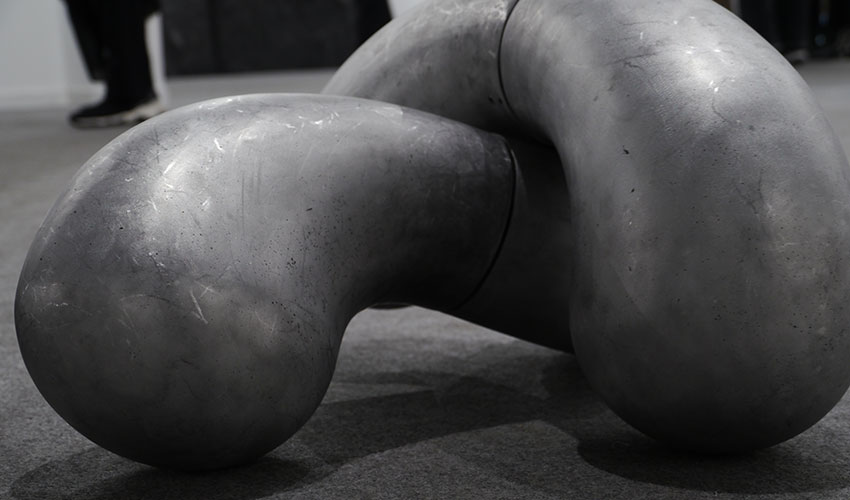Text by Meritxell Rosell

How viewers relate to 3-dimensional artworks has been one of the central questions of contemporary sculpture: the reappropriation of space and reinvention of form, even the invisible or virtual presences that remind us that we need to see beyond what we can see.
In A Glorious Accident (2020) by Eugenio Ampudia, five interconnected mechanical pieces made of galvanized cast aluminium move and intertwine sinuously on the exhibition floor. With this modular kinetic sculpture, the artist interrelates form, space, and movement and –as usual in his practice– includes the spectator as a participant in the artwork, generating a sense of visual estrangement and optical confusion.
Eugenio Ampudia is currently one of the most recognised Spanish artists. Over the course of two long decades, he has developed a critical examination of the art system (which he accomplishes by making its underlying mechanisms visible). He has questioned the role of the institutional keepers of artworks (galleries), the spaces they provide and their character.
Using mixed media (including video installations, sculpture, painting, and activations), Ampudia explores the role of the artist as a promoter of ideas, the political role of creators, the meaning of art pieces, the strategies that allow to bring them to life, their mechanisms of production, promotion and consumption, the efficiency of spaces assigned to art, as well as the analysis and experience of those who watch and interprets them.
In A Glorious Accident, Ampudia inquires about our biological origins, the possibility of genetic memory and the meaning of being. Many hundreds of thousands of years ago, a single cell adapted to its surroundings’ conditions and evolved into a sentient and thinking human being.
Those early unicellular organisms –that inhabited the waters of the Primordial Ocean progressively united and formed symbiotic combinations, sometimes in the form of tubular structures in order to have better access of nutrients. Within time, those tubes gradually closed, generating much more complex multicellular organisms that, a long time afterwards, managed to leave the water in multiple autonomous forms, some of them with a high level of conscience, that is, of “being”.
In search of new possibilities, these organisms started to reproduce and expand and in turn, divide again, originating different organs with determinate functions inside a living thing. Ampudia states that the starting point of this kinetic installation is neuronal conscience and experiential selection: The experience stems from the enormous quantity of reciprocal interactions between memory systems and systems related to perceptive categorisation. This way, the artist questions the consciousness of beings and their implications. What we are and “with what” we are, where do we start to be and which part of us is what makes us be.
In times of social unrest, we tend to reassess and question our most basic metaphysical assumptions. What is mean to be living and being a sentient and thinking human being. With this pice, Ampudia seems to push us towards this re-examination. At the same time, as it was regular in Ampudia’s pieces, the spectator becomes an active and integral part of the work itself, interpreting it in its own way. The artist wants to give the possibility to leave space to the unpredictable to suggest new visions to understand the art and the areas dedicated to it with his audience.






